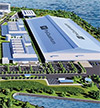Frontline: What’s Driving Down FDI?
The fear of trade wars and protectionist policies are being blamed for the overall decline in global foreign direct investment.
Q1 2019

Alabama is one of many states that have benefited from direct foreign investment (FDI) by companies that have opened U.S. manufacturing facilities, purchased equipment, hired workers, and created products and services in this country. However, some economic development experts say foreign direct investment is under-appreciated as a driver of economic prosperity in the U.S.
According to the Washington, D.C.-based Organization for International Investment (OFII), there are 7.1 million U.S. workers employed by international companies; international companies employ 20 percent of America’s manufacturing workforce; and more than 60 percent of the manufacturing jobs created in the past five years can be attributed to international companies.
However, global FDI has been trending lower, the United Nations trade and development agency (UNCTAD) reported late last year. Global foreign direct investment fell by 41 percent to $470 billion in the first six months of 2018, the lowest since 2005.
According to UNCTAD Investment Chief James Zhan, President Trump’s U.S. tax reforms were the main cause of the slump, which followed a 23 percent fall in 2017, as American firms repatriated a net $217 billion from foreign affiliates.
“The investment flows are more policy-driven and less economic cycle-driven,” Zhan told a news conference, citing the U.S. tax reform and economic liberalization in China. “Overall, the global picture is gloomy, and the prospect is not so optimistic.”
There are 7.1 million U.S. workers employed by international companies; international companies employ 20 percent of America’s manufacturing workforce; and more than 60 percent of the manufacturing jobs created in the past five years can be attributed to international companies. Organization for International Investment (OFII) International supply chains became an increasingly important driver of international trade until 2011 but have since stagnated, Zhan says. “It’s difficult to tell whether we are at a turning point (in globalization) or if this is only a slowdown.”
In the first half of 2018, China became the top destination for FDI, with $70 billion of inflows, a 6 percent rise. Flows into Europe fell by 93 percent. The United States was the third-biggest destination, with $46.5 billion of inflows.
Comment From OFII
According to OFII, FDI in the U.S. has declined 15 percent since 2000. One major reason is that the world has become a much more competitive place, says Aaron Brickman, a senior vice president with the Washington, D.C.-based OFII. “The world is a vastly more competitive place for cross-border investment than it was 20 or 30 years ago. And, in some ways, the U.S. has been standing still and not reacting to global economic changes — and structural factors and improvements our competitors in other countries have been making,” Brickman told Area Development.
Brickman says a number of factors play a role in attracting FDI; they include infrastructure (roads, rail, bridges, communication), proximity to markets, access to markets through free-trade agreements, taxes, and the regulatory environment.
On the positive side, he notes that a number of cities, states, and regions have developed the ability to effectively work with inbound companies. “Deals don’t flow to nations; they flow to specific cities, towns, states, regions. We have seen some improvements over the last 10 to15 years with regard to how U.S. economic development organizations align themselves, prepare and strategize, and compete globally,” Brickman says.
Some factors that impact U.S. competitiveness have been changing for the better, Brickman says, citing the deregulatory and tax environments as areas “international companies are feeling more positive about. But, to reverse that long-term, downward trend is not about what takes place in one year or another, but rather structural improvements made in a more systematic manner over time. It’s important to ensure that policymakers at all levels understand the importance of FDI and the benefits it brings.”
President Trump’s U.S. tax reforms were the main cause of the slump, which followed a 23 percent fall in 2017, as American firms repatriated a net $217 billion from foreign affiliates. James Zhan, Investment Chief, UNCTAD Brickman continues, “In some respects, trade uncertainty is removing, in at least the short-to-medium term, some of the benefits we have seen on the tax side, and that’s not a good thing.” For example, auto tariffs are viewed as the largest threat to U.S. competitiveness by company CFOs that OFII periodically surveys. Tariffs are a key factor for global companies considering expanding their existing operations in the U.S. or locating here, and the jobs they would be creating, Brickman says.
The fact that U.S. manufacturing employees earn higher wages than those in foreign countries is not a negative factor for foreign countries considering the U.S. The kind of jobs created by international companies in the U.S. are inherently high-skill, high-expertise jobs, paying substantially higher average wages than paid by private-sector U.S. companies. “So, international companies are not selecting the U.S. as a low-wage destination. They are coming here because of expertise and high skills,” Brickman explains.
Foreign companies contribute significantly to workforce development programs. As stated, within the last five years, more than 60 percent of all manufacturing jobs were created by FDI, and a quarter of all exports from the U.S. were made by those companies. They also account for 16 percent of all R&D performed by U.S. companies.
“Over the last five years, we have seen some interesting trends with FDI in the U.S. from Brazil, Chile, Argentina, and Thailand showing strong growth. Some U.S.-based economic development organizations have been putting more effort into courting smaller economies that are growth markets for FDI,” Brickman notes. “It is vital for the U.S. to remain attractive to international companies and ensure that policies are in place for international companies to thrive and succeed.”
Despite the overall slowdown, money going into newly announced global startup projects, so-called greenfield investments, rose 42 percent in the first half of 2018, according to UNCTAD. Whether that trend will continue remains to be seen.
Project Announcements
Wyandot Snacks Expands Marion, Ohio, Production Operations
08/29/2025
Trane Technologies Expands Fort Smith, Arkansas, Operations
08/29/2025
BioMADE Plans Boone, Iowa, Bioindustrial Manufacturing Operations
08/29/2025
Choice Fabricators Expands Rainbow City, Alabama, Production Operations
08/29/2025
Ranovus Expands Ottawa, Ontario, Semiconductor Operations
08/29/2025
Belgium-Based Stow Group Plans Gordon County, Georgia, Manufacturing Operations
08/28/2025
Most Read
-
Tariffs, Talent, and U.S. Expansion
Q3 2025
-
What We’re Getting Wrong About Gen Z’s Future in the Skilled Trades
Q3 2025
-
Data Center Demand Stabilizes Amid Changing Market Forces
Q3 2025
-
A New Course for U.S. Shipbuilding
Q3 2025
-
Optimizing Your Rail-Served Transportation Network: Strategy Before Steel
Q2 2025
-
In Focus: AI Is Changing Incentives Math
Q2 2025
-
Rewriting the Rules of Warehouse ROI
Q3 2025



